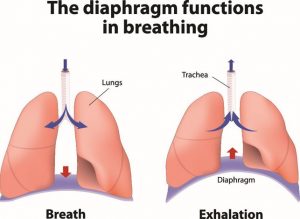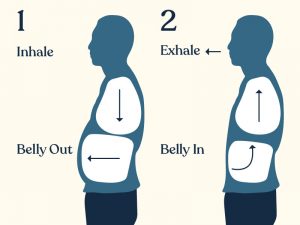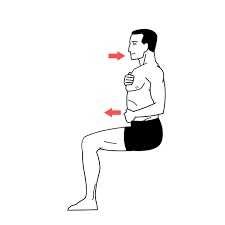Breathing is the thing we do constantly in life, yet we often forget about the importance of it. It is our easiest and most natural method for stress relief. With a bit more awareness it can help us in stressful moments.
Normally in stressful situations we breath into the “top” of our lungs. At the upper lobes of our lungs there is not much space for expansion to allow more oxygen in. If we try in those moments to breath deeper and slower into our belly area, our whole body will slowly relax. This is known as diaphragmatic breathing. I know that this is far easier said then done. Even as a Yoga teacher and Remedial therapist I need to be more conscious of it.
In the yoga philosophy our lives are counted in breaths (we have a certain amount of breaths we take). Through practicing pranayamas (breathing techniques), we can in some way expand our lives.
Pranayama – Breath Control
- Prana – vital energy/life force
- Ayama – control
- Pranayama – “expansion of vital energy”
Breath control:
–Inhalation (puraka)
–Exhalation (rechaka)
–Breath retention (kumbhaka)
- Antara Kumbhaka: Breath retention after inhalation
- Bahir Kumbhaka: Breath retention after exhalation
The ancient yogis learned that by controlling the breath, you can influence every aspect of your life. If you have ever caught yourself sighing at the end of a long day, this is an example of the body’s natural way of relieving stress. The more you become aware of the power of the breath, the more you can benefit from its numerous physical and emotional benefits.
Research:
Researchers have documented the benefits of a regular practice of simple deep breathing, which include the following:
- Reduced anxiety and depression
- Lower/stabilized blood pressure
- Increased energy levels
- Improved immunity
- Decreased feelings of stress and overwhelm
- Reduction in PTSD symptoms
In the medical community, there is a growing appreciation for the positive impact that deep breathing can have on our physiology, both in the mind and the body. According to the research many of these deep-breathing benefits can be attributed to reducing the stress response in the body. To understand how this works, let’s look at the stress response in more detail.
Pranayama as a tool to counter stress:
When you experience stressful thoughts, your sympathetic nervous system triggers the body’s ancient fight or flight response. This gives you a burst of energy to respond to the perceived danger. Your breathing becomes shallow and rapid, and you primarily breathe from the chest and not the lower lungs. In turn you may feel short of breath. This is a common symptom when you feel anxious or frustrated. At the same time, your body produces a surge of hormones such as cortisol and epinephrine (also known as adrenaline). These hormones increase your blood pressure and pulse rate and put you in a revved-up state of high alert.
The effects of deep breathing:
With deep breathing, you can reverse these symptoms instantly and create a sense of calm in your mind and body. When you breathe deeply and slowly, you activate the parasympathetic nervous system, which reverses the stress response in your body. Deep breathing stimulates the main nerve in the parasympathetic nervous system, the vagus nerve. This in turn slows down your heart rate, lowering your blood pressure, and calming your body and mind.
In addition, with deep breathing, you engage the abdominal muscles and diaphragm instead of the muscles in the upper chest and neck. This conditioning of the respiratory muscles results in improved efficiency of oxygen exchange with every breath. It allows more air exchange to occur in the lower lungs. It also reduces strain on the muscles of the neck and upper chest, allowing these muscles to relax. In short, deep breathing is more relaxing and efficient, allowing higher volumes of oxygen to reach the body’s cells and tissues.
As well as reversing the physical stress response in the body, deep breathing can help calm and slow down the emotional turbulence in the mind. Breathing can have an immediate effect on diffusing emotional energy so there is less reactivity to your emotions.

What happens during diaphragmatic breathing?
The diaphragm is a dome-shaped respiratory muscle found near the bottom of your ribcage. When you inhale and exhale air, the diaphragm and other respiratory muscles around your lungs contract. The diaphragm does most of the work during the inhalation part. As the diaphragm contracts, your lungs can expand into the extra space and let in as much air as is necessary.
Muscles in-between your ribs, known as intercostal muscles, expand your rib cage and work together with your diaphragm to expand the lungs.
Muscles near your collarbone and neck help expand the upper lobes of the lungs. They may kick in when something makes it harder for you to breathe properly.
Diaphragm breathing basics
Here’s the basic procedure for diaphragmatic breathing:
- Sit in a comfortable position or lie flat on the floor, your bed, or another comfortable, flat surface.
- Relax your shoulders.
- Put a hand on your chest and a hand on your stomach.
- Breathe in through your nose for about two seconds. You should experience the air moving through your nostrils into your abdomen, making your stomach expand. During this type of breathing, make sure your stomach is moving outward while your chest remains relatively still.
- Purse your lips (as if you’re about to drink through a straw), press gently on your stomach, and exhale slowly for about two seconds.
- Repeat these steps several times for best results.

https://www.youtube.com/watch?v=DZlZ4MsQQk8
Autonomic nervous system and your breath
Breathing is part of your autonomic nervous system (ANS). This system is in charge of essential involuntary bodily processes, such as:
- digestive processes
- how quickly you breathe
- metabolic process that affect your weight
- overall body temperature
- blood pressure
The ANS has two main components: the sympathetic and parasympathetic divisions. Each division is responsible for different bodily functions.
The sympathetic controls your fight-or-flight response, the parasympathetic is in charge of everyday processes.
So even though most ANS functions are involuntary, you can control some of your ANS processes by doing deep breathing exercises.
Taking deep breaths can help you voluntarily regulate your ANS, which can have many benefits. These include lowering your heart rate, regulating blood pressure, and helping you relax. These all help decrease how much of the stress hormone cortisol is released into your body.
Risks and research
Diaphragmatic breathing isn’t always useful on its own. In some cases deep breathing is often most effective as a treatment when combined with a trusted source cognitive-behavioral therapy (CBT) or hypnotherapy.
Deep breathing exercises aren’t always helpful if you have a generalized anxiety disorder (GAD) or another similar mental health condition.
GAD can last for up to several months or years, and the numerous worries or anxieties that accompany it may feel hard to control. Deep breathing exercises may cause more anxiety if they don’t appear to be working.
Techniques like cognitive-behavioral therapy (CBT) are usually a better option for helping someone cope with anxiety or other matters of mental health.
Get in touch with your GP if you’re suffering from anxiety and need further help.
You may also find these related blogs on our website helpful:

